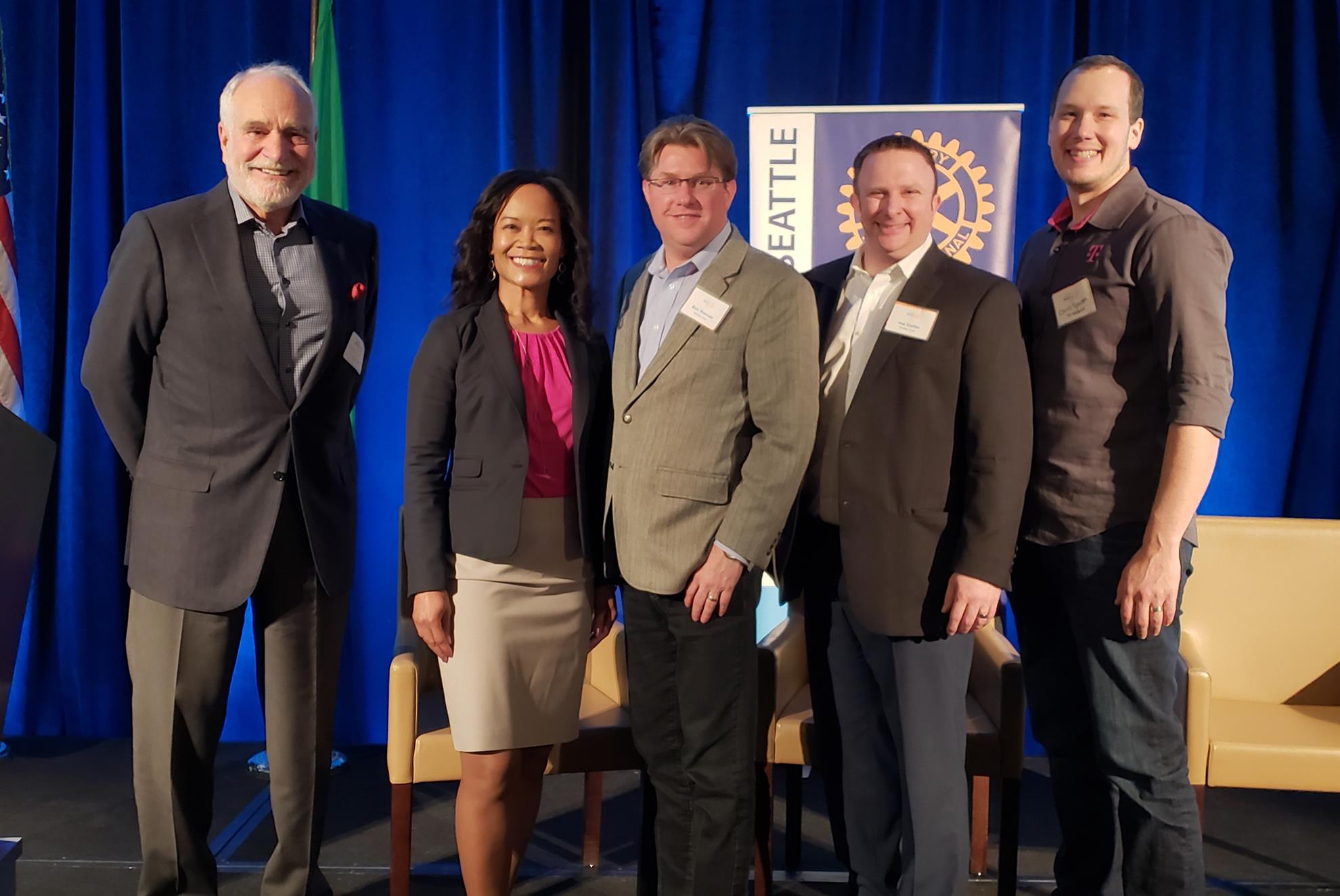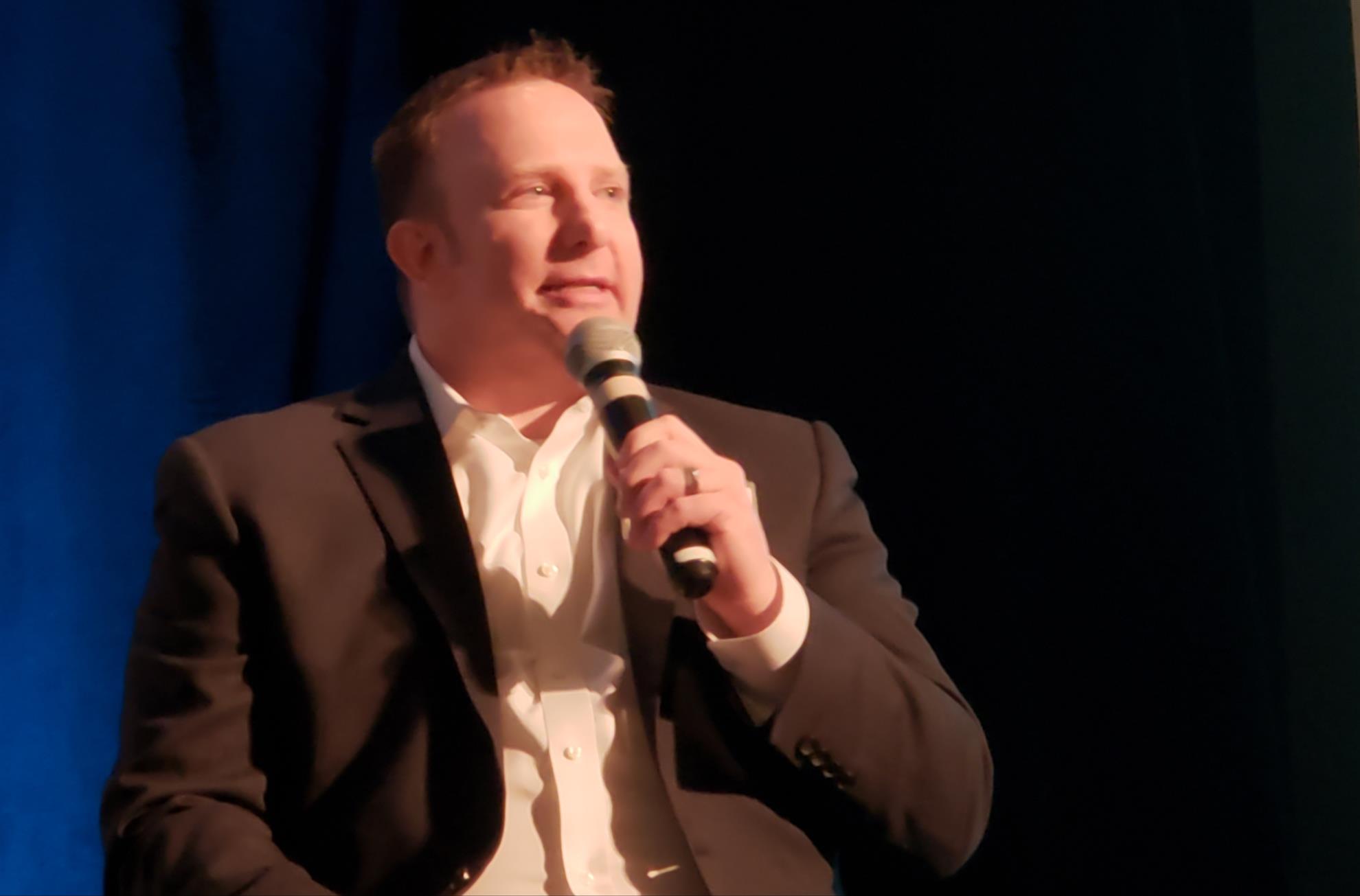 Our weekly program focused on the nearly unfathomable world of blockchains and cryptocurrencies. Past President Karl Ege introduced the panel of two Perkins Coie attorneys, Joe Cutler and Dax Hansen, who are partners leading a 30 person team specializing in the world of bitcoin and blockchains. Christopher Spanton, Senior Architect of Blockchain at T-Mobile rounded out the three-person panel.
Our weekly program focused on the nearly unfathomable world of blockchains and cryptocurrencies. Past President Karl Ege introduced the panel of two Perkins Coie attorneys, Joe Cutler and Dax Hansen, who are partners leading a 30 person team specializing in the world of bitcoin and blockchains. Christopher Spanton, Senior Architect of Blockchain at T-Mobile rounded out the three-person panel.
 Joe began demystifying blockchain and asserted that it is not hype. He quoted the Harvard Business Review, “blockchain will do to financial systems what the internet did to the media.” A blockchain consists of a distributed group of connected computers that programmatically reach agreement with respect to the status of, or changes to, certain shared data as used in financial transactions. Blockchain started as a financial ledger, eliminating all intermediaries, and creating a more secure system of value transfer. It is much more difficult to hack into the information because of the network of connected computers simultaneously authenticating data. Data is not stored on a central storage system.
Joe began demystifying blockchain and asserted that it is not hype. He quoted the Harvard Business Review, “blockchain will do to financial systems what the internet did to the media.” A blockchain consists of a distributed group of connected computers that programmatically reach agreement with respect to the status of, or changes to, certain shared data as used in financial transactions. Blockchain started as a financial ledger, eliminating all intermediaries, and creating a more secure system of value transfer. It is much more difficult to hack into the information because of the network of connected computers simultaneously authenticating data. Data is not stored on a central storage system.
Why does blockchain matter? Through blockchain, any digital asset can be issued and transferred on similar networks to move and track value, information or property. In the future, we can expect to use blockchain for land and title transfer and certification; with all of our internet-connected devices operating our phones, homes, televisions, and cars; with energy and utility management, supply chain management, and health care record management, to name a few.
 Think of blockchain as the operating system, like Microsoft’s operating system. Think of Bitcoin as an application, such as Microsoft Word. By eliminating intermediaries (third parties like PayPal) Bitcoin makes possible nearly instantaneous transactions and costs savings.
Think of blockchain as the operating system, like Microsoft’s operating system. Think of Bitcoin as an application, such as Microsoft Word. By eliminating intermediaries (third parties like PayPal) Bitcoin makes possible nearly instantaneous transactions and costs savings.
Christopher Stanton of T-Mobile is creating an identity platform to prove the provenance (authentication) of the technology. How do we secure when, who, and how information is collected and created and is it cryptographically provable? Cryptography is used to protect email messages, credit card information, and corporate data.
Joe Cutler closed the program with two assertions:
1. This technology is very exciting.
 We started our meeting with the familiar. Linda Rough led us in song with the song Seattle from the 1960's show, Here Come the Brides; Cathy Gibson’s inspiration reminded us of the beauty of the snow, and the patience we need to get through it; we recognized 33 members celebrating 1 to 40-year membership anniversaries; Jeff Borek, Seattle Rotary Service Foundation President, implored us to make our SRSF and Rotary International annual gifts to move us to 90% participation; and the Rotary Business Mentors committee, co-chaired by Bill Marshall and Terry Van Nostrand, showcased University of Washington Foster School of Business students and the 20-year program where our mentors and the students have served over 1,000 Seattle area businesses.2. Blockchain technology won’t just change financial transactions, it will change the world of all transactions in the next 30 years.
We started our meeting with the familiar. Linda Rough led us in song with the song Seattle from the 1960's show, Here Come the Brides; Cathy Gibson’s inspiration reminded us of the beauty of the snow, and the patience we need to get through it; we recognized 33 members celebrating 1 to 40-year membership anniversaries; Jeff Borek, Seattle Rotary Service Foundation President, implored us to make our SRSF and Rotary International annual gifts to move us to 90% participation; and the Rotary Business Mentors committee, co-chaired by Bill Marshall and Terry Van Nostrand, showcased University of Washington Foster School of Business students and the 20-year program where our mentors and the students have served over 1,000 Seattle area businesses.2. Blockchain technology won’t just change financial transactions, it will change the world of all transactions in the next 30 years.
President Cindy closed the meeting with a quote from Stewart Brand, “Once a new technology rolls over you, if you’re not part of the steamroller, you’re part of the road.”
The meeting today gave us a brief introduction of what is to come in the world of blockchain (the operating system) and the applications (i.e. Bitcoin, etc) which we will be using in our daily lives.
